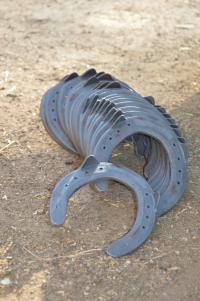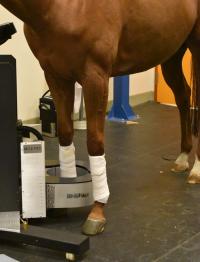Dr. Stover's Top Myths About Equine Orthopedic Injuries
Dr. Sue Stover delivered the Frank J. Milne State-of-the-Art Lecture at the American Association of Equine Practitioners (AAEP) Convention in December 2022. The presentation included her top myth busters about equine orthopedic injuries.
1. Myth: Equine performance sports, such as racing, are invulnerable.
Fact: Equine performance sports are vulnerable.
Horse injury and loss, associated welfare issues, as well as human injuries and financial considerations influence equine sports’ social license to operate (i.e. ongoing acceptance by the general public). The veterinary community has an important role in enhancing equine health and welfare through injury prevention and management.

2. Myth: Thoroughbreds have small, weak bones.
Fact: Thoroughbreds successfully adapt their skeletons to the most recent loading events.
The skeleton is a living structure, and bones have a special ability to repair and regenerate. Bone is made of minerals so it has the strength and stiffness to support the body, but it is also very heavy to carry. Consequently, the skeleton is dynamic; it gets rid of mineral when it does not need it and applies mineral when it does need it.
If we reduce the activity on the bone structure, it develops holes because the body is removing mineral to make it easier and more efficient for movement. The musculoskeletal system is constantly adapting to sustain increasing or changing loads. The nature of the training determines if the bone gets stronger and adapts, resulting in optimum performance, or whether it gets weaker, is susceptible to injury, and results in poor performance. Reduced exercise intensity can actually lead to increased bone loss. As training advances, the musculoskeletal system must adapt, which reduces stresses and strains, and prevents damage.
3. Myth: Catastrophic fractures are due to a bad step in a hole.
Fact: Catastrophic fractures are due to training or competing on bones with a pre-existing injury.
Severe damage causes bone tissue death. Bone remodeling removes damage and replaces bone, but repair and healing take time. The short period in which an area of damage has been removed results in weakening of the bone. If training and competing continue during this period, there is less bone material available to spread the forces out. As the strains on these areas increase, so does damage to the bone. Continued training on damaged bone leads to stress fractures, and eventually complete fractures.
4. Myth: Joint fractures are different from stress fractures of long bones.
Fact: The only difference between the development of a stress fracture in a long bone and remodeling of a fracture that involves the bone under the cartilage in a joint is that the overlying joint cartilage prevents expansion and the formation of a bone callus.
Pre-existing injury predisposes bones to future fractures. However, if injuries are identified early enough, lesions can be repaired by the same mechanism, regardless of whether the injury is to a long bone or involves the joint.
5. Myth: Catastrophic musculoskeletal injuries are the cost of doing business.
Fact: Pre-existing injuries that predispose horses to catastrophic fracture develop over weeks to months and provide opportunities for intervention and prevention.
Research has shown that more than 85% of catastrophic injuries are associated with pre-existing injuries. This means that there is an opportunity to intervene and prevent more than 85% of these deaths. This is actually already happening.
California, the New England Region, and New York reported a 40-50% reduction in the catastrophic musculoskeletal injury rate in the last few years. This is due to a number of changes, including an emphasis on a “culture of safety”, increased training observations, enhanced collaborations between trainers and veterinarians, reduced medication allowances and withdrawal times for intra-articular corticosteroids.

6. Myth: It is impossible to prevent injuries.
Fact: The risk for injuries can be reduced by managing factors such as hoof conformation and shoeing, as well as training and competing schedules.
Injuries occur when there is an imbalance between the rate of damage formation and the rate of repair and adaptation. Repair is optimized in healthy, young athletes, but healing still requires a minimum amount of time. Healing time can be prolonged, but not shortened. However, we can influence the rate of damage accumulation.
The rate of damage accumulation depends on the magnitude of the load and the rate of load cycles (strides). One of the things that affects load magnitude is hoof conformation. Things like heel angle and toe grabs on shoes can increase the risk for suspensory apparatus injury. The load magnitude is also affected by exercise intensity, which increases ground reaction force.
7. Myth: The racetrack surface is the cause of clusters of catastrophic injuries.
Fact: The race surface "may" be a factor, but other factors likely play a role and should be investigated.

The load magnitude is affected by the surface and associated ground reaction forces, which are influenced by moisture, mechanical manipulation (dragging), etc. Surface stiffness affects fetlock angle, with data showing differences in fetlock hyperextension between different surfaces (dirt, synthetic, turf). The hoof is also more stable on some surfaces than others.
Importantly, we characterize surfaces by their components, but their behavior can differ. Not all synthetic surfaces are alike and not all dirt surfaces are alike. How we manage the surfaces makes a huge difference. Stepping in an existing hoof print in the surface, for example, increases force on the hoof, which increases suspensory ligament strain.
Injuries can be multifactorial. The surface does have a big role, but so do other factors. We will not make a difference until we understand all the factors and attempt to manage them.
8. Myth: It is impossible to know when individual horses are at risk for injury.
Fact: While it is difficult to predict injury in performance horses, there are typical times of high risk that warrant careful consideration.
Injuries are generally related to three scenarios:
- In general, fractures of the shoulder, humerus, and tibia are due to insufficient conditioning. They typically occur early in training and are related to high increases in training load.
- Injuries due to deconditioning after rehabilitation occur soon after a return from lay-up. Rehabilitation unloads the skeleton, leading to bone loss, and the bones then experience high increases in load upon return to full training.
- Injuries due to “over training” occur later in the training program, during high intensity training for a long period without opportunity for recovery. These injuries are more common in older horses.
Relatively little exercise at a new level is required to stimulate adaptation and gain bone mass. Bone responds to the level (magnitude) of work, not the amount of work.
9. Myth: Injury detection and diagnosis are easy to determine in individual horses.

Fact: Injury detection and diagnosis in individual horses is challenging. It benefits from a thorough medical history, index of suspicion, physical examination, training and behavior observations, and diagnostic imaging.
Research studies detect trends in populations. Applying results to individual horses is challenging. Lameness might not be evident if both legs are affected. However, we know that previous lameness is associated with more severe injury later. Early signs of injury often include changes in demeanor, poor performance, and transient lameness.
It is important to think about when sufficient injury occurred to the skeletal structure. This is a time when high impact loads induce microdamage in a small area, creating mild injury, and possibly pain and lameness. Weeks to months later, as the repair resorbs the microdamage, creating transient bone loss, the horse may be less painful and without obvious lameness, but it is a period that creates high fracture risk later.
Increased collaboration between veterinarians and owners/trainers is essential because knowledge and diagnostics make a significant difference. Research has shown that horses had a lower likelihood of fatal humeral fracture if they were diagnosed by bone scan. Three dimensional imaging methods (computed tomography (CT), positron emission tomography (PET)) can provide a different perspective. Once we recognize what is going on with these horses, they can be managed and they do well.
10. Myth: Training schedules should be determined based on tradition.
Fact: Knowledge of the processes that occur with skeletal overload and over-repair responses to increases in training intensity or changes in gymnastic events can assist in training individuals to optimize performance without injury.
Training induces cycles of bone damage and repair. Optimally, initial damage is followed by repair and gain in strength. If we wait to increase the load until that adaptation has occurred, there is going to be some microdamage, but it is only going to come down to baseline and then recover and adapt to get to further capacity.
Training that capitalizes on the gain in strength achieves further gain in strength. Training that is too intense further weakens damaged tissues before repair is complete. Loading too soon or too often results in performance decline and injury. Loading too late or too infrequently results in a stagnation in performance. Optimal loading results in adaptation and an increase in performance.
Relatively little exercise is required to maintain bone mass at the current activity level. The work must be relevant to what you are doing, but it does not take a lot of work to maintain it. Additional work is just more damage. Athletes are built with training. The nature of the training influences high versus poor performance.
In summary, skeletal injuries in equine athletes are preventable because:
- Injuries are the acute manifestation of a chronic process.
- We can influence the balance between two competing rates -damage accumulation and repair.
“It is not easy, but in recent years racing has reduced catastrophic injuries by 40-50%,” said Stover. “Think of what we can do if we reduce attrition from mild injuries, extend racehorses’ careers, and take away the large economic toll. The industry is already proving that we are capable of doing that.”
